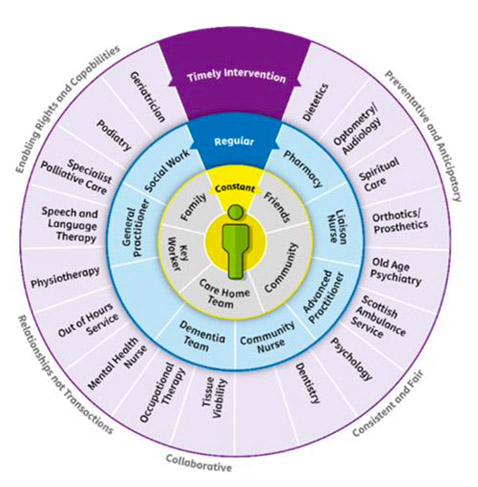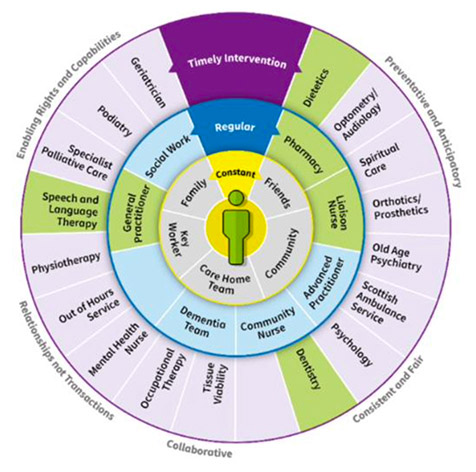My Health, My Care, My Home - healthcare framework for adults living in care homes: summary
Framework providing a series of recommendations that aims to transform the healthcare for people living in care homes.
2. The Multi-Disciplinary Team
A multi-disciplinary approach allows people to benefit from the combined skills and expertise of health and social care professionals who are working together to optimise health and care outcomes.
A constant desire emanating from our programme of engagement is the need to adopt a multi-disciplinary team (MDT) approach to healthcare. This approach is the foundation on which we have built the framework.
There are many different individuals and professionals who support the health and wellbeing of an individual living in a care home and provide constant, regular and timely intervention. This is represented in the concentric wheel at figures 3. An example showing an individual with swallowing problems can be found at figure 4.
The framework recommends regular MDT meetings and good communication between the professionals involved in an individual's care. For practical reasons MDT meetings may take place virtually, and should happen as frequently as is necessary. This will differ depending on the person and/or the care home; smaller care homes may wish meetings to take place monthly whereas larger care homes may need to meet more frequently.


Care home staff and community MDTs report difficulties when dealing with several GP practices who each have different ways for requesting advice, visits and prescriptions. It is also inefficient for staff in the same GP practice to visit multiple care homes on the same day. Therefore, the framework recommends that each care home should be linked with a named GP practice that will play a lead role with that home. However there may be someone living in the care home who chooses to remain registered with a GP practice which is not the lead practice for that home, and this request should be accommodated whenever possible.
Recommendations
2.1 Regular MDT meetings (face to face, virtual or hybrid) should take place involving the care home team, the GP practice and relevant other professionals to co-ordinate and plan healthcare.
2.2 The administration and support of MDT meetings should be co-ordinated between the HSCP and the care home.
2.3 People living in care homes should have the opportunity to involve a family member or any legally appointed welfare guardian or attorney during consultations with members of the MDT.
2.4 As MDTs form and develop, opportunities for shared learning should be explored, to develop the knowledge, skills and experience required to provide the best possible care.
2.5 Wherever possible, each care home should be linked with a named GP practice that will play a lead role with that home. Where this is not possible, HSCPs should work with the local care homes and GP practices to establish safe and reliable alternative arrangements that enable effective MDT working.
2.6 People living in care homes should be made aware of the benefits of being registered with the GP practice that is linked to the care home that they live in, however they should not be forced to change GP practice.
2.7 Health Boards should review Local Enhanced Services (LES) that relate to care homes and revise them in line with the aspirations of the 2018 GP contract and the ambitions of this framework.
2.8 HSCPs must ensure that there is access to appropriate specialist provision when commissioning with the care home sector to provide specific services for people with highly complex care needs.
2.9 Care home teams must be provided with contact details and referral routes for all members of the MDT. Where these are not clear, the HSCP should work with the care home to obtain these.
Contact
Email: carehomeshealthcare@gov.scot
There is a problem
Thanks for your feedback